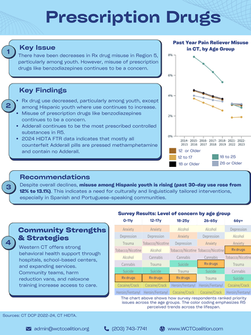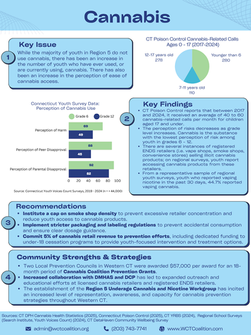2025 Priority Report
Region 5 Infographics
Epi Profiles
Strategic Prevention Framework
The SPF includes these five steps:
1 . Assessment: Identify local prevention needs based on data (e .g ., What is the problem?)
2 . Capacity: Build local resources and readiness to address prevention needs
(e .g ., What do you have to work with?)
3 . Planning: Find out what works to address prevention needs and how to do it well
(e .g ., What should you do and how should you do it?)
4 . Implementation: Deliver evidence-based programs and practices as intended
(e .g ., How can you put your plan into action?)
5 . Evaluation: Examine the process and outcomes of programs and practices
(e .g ., Is your plan succeeding?)





GUIDING PRINCIPLES:
CULTURAL COMPETENCE
SAMHSA has identified the following cultural competence principles for prevention planners:
-
Include the target population in all aspects of prevention planning
-
Use a population-based definition of community (i .e ., let the community define itself)
-
Stress the importance of relevant, culturally appropriate prevention approaches
-
Employ culturally competent evaluators
-
Promote cultural competence among program staff, reflecting the communities they serve
SUSTAINABILITY
A primary goal of an effective strategic planning process like the SPF is to identify the right combination of programs and practices to address local prevention priorities . Many factors contribute to effectiveness in prevention . In general, programs and practices must operate in a variety of community settings and influence local risk and protective factors at both the individual and environmental levels . Thus, a comprehensive prevention plan might include:
-
A school-based youth skills promotion program
-
Parent education to support children’s healthy development
-
Organizational/community rules and regulations that support healthy behavior
-
Enforcement of rules and regulations that support healthy behavior
CADCA’s 7 Strategies for Community Change
Individual Change Strategies
1. PROVIDING INFORMATION – Educational presentations, workshops or other data presentations (e.g., public announcements, brochures, community meetings or social media).
2. BUILDING SKILLS – Workshops or other activities designed to increase the skills of participants, members and staff needed to achieve population-level outcomes (e.g., training, technical assistance, distance learning, strategic planning retreats and curricula development).
3. PROVIDING SUPPORT – Creating opportunities to support people to participate in activities that reduce risk or enhance protection (e.g., providing alternative activities, mentoring, referrals, support groups or clubs).
Environmental Change Strategies
4. ENHANCING ACCESS/REDUCING BARRIERS – Improving systems and processes to increase the ease, ability and opportunity to utilize those systems and services (e.g., ensuring childcare, transportation, safety, special needs and cultural and language sensitivity).
5. CHANGING CONSEQUENCES (INCENTIVES/DISINCENTIVES) – Increasing or decreasing the probability of a specific behavior that reduces risk or enhances protection by altering the consequences for performing that behavior (e.g., increasing public recognition for deserved behavior, individual and business rewards, scholarships, citations, fines or revocations/loss of privileges).
6. PHYSICAL DESIGN – Changing the physical design or structure of the environment to reduce risk or enhance protection (e.g., parks, landscapes, signage, lighting or outlet density).
7. MODIFYING/CHANGING POLICY – Formal change in written procedures, by-laws, proclamations, rules or laws with written documentation and/or voting procedures (e.g., workplace initiatives, law enforcement procedures and practices, public policy actions and systems change within government, communities and organizations).
Science of the Positive
The Science of the Positive is the study of how positive factors impact culture and experience. It focuses on how to measure and grow the positive, and has been applied over decades with agencies, communities, and businesses. It is based on the core assumption that the positive is real and is worth growing – in ourselves, our families, our workplaces, and our communities (Linkenbach, 2007).

Those of us who work in health and safety can become hyper-focused on the dangers and problems we are trying to decrease. The Science of the Positive reverses this problem-centered frame, and focuses on growing the healthy, positive, protective factors that already exist in our communities. When we start to look at the world through this positive, hopeful lens, it has a profound impact on the questions we ask, the data we collect, and the way we address health and safety issues.
The Science of the Positive should not be confused with simple “positive thinking.” It is a rigorous process that works across entire cultures. And while the Science of the Positive is based on the core assumption that the positive exists in every community and culture, it recognizes that suffering, pain, and harm are very real. One of its principal outcomes is to reduce suffering in our families, our communities, and ourselves.
Four essential domains – Spirit, Science, Action, and Return – make up the transformational process of the Science of the Positive. These stages, when fully engaged, work together to create a synergistic Cycle of Transformation.
SPIRIT Start with purpose.
Spirit is the why—the core values and intentions behind our actions. It gives life to our efforts and keeps us grounded in hope, authenticity, and meaning. Without Spirit, action can become aimless or misdirected. Spirit reminds us that transformation starts from within, fueled by hope, connection, and a shared commitment to the Positive.
SCIENCE Use rigorous inquiry to understand reality.
After clarifying our purpose, we apply Science to gain accurate understanding. This involves asking the right questions, challenging misperceptions, and using data to guide decision-making. Science transforms busyness into effectiveness, helping us act on truth rather than assumption. It also reinforces that positive change is most sustainable when informed by careful observation and learning.
ACTION Act with intention for change and transformation.
With clarity and insight, we take deliberate action—not just to create surface-level change, but to spark deeper, lasting transformation. Action is most powerful when rooted in Spirit and guided by Science. True transformation shifts not just behaviors, but beliefs and paradigms, creating cultural momentum toward health and safety.
RETURN Pause, reflect, and renew.
Return is the essential practice of stepping back—to rest, reflect, and evaluate before beginning the cycle again. It prevents burnout and ensures we learn from experience. Return gives us the wisdom and renewed energy to re-engage with purpose and clarity, creating space for continuous growth and deeper impact.
Core Principles
BE POSITIVE
The Positive is our natural state—who we truly are beneath the layers of protection built in response to pain or fear. It is the source of hope, love, forgiveness, and acceptance. Whether or not we acknowledge the Positive within ourselves and others shapes our lives: either we live from a place of connection and truth, or from fear and avoidance. Living Positively means daring to face our deepest fears—not of death, but of fully living—and accepting the responsibility that comes with owning our goodness. The Positive is not just a personal truth; it’s a shared spirit of hope and community, reminding us that, regardless of our conditions, we already have what we need to improve ourselves and the world around us.
BE PRESENT
The Present is the only place transformation can happen. It is where truth lives—not in a reinterpreted past or imagined future. When we ground ourselves in the here and now, we align with reality and create space for the Positive to emerge. Focusing on the present challenges our desire for control and certainty, but it opens the door to courage, authenticity, and growth. Through honest, present-moment dialogue and by honoring people as they are—not who we wish them to be—we co-create a space of hope, trust, and real connection. Being present is not passive; it’s the most powerful place from which to act.
BE PERCEPTIVE
Perception defines our experience. What we perceive becomes our reality—even if it isn’t accurate. This makes perception both powerful and risky. We constantly filter the world through lenses shaped by fear, judgment, and past experiences, creating misperceptions that lead to pain and disconnection. Being Perceptive means actively working to correct these distortions and choosing to see the deeper Positive in every person and situation. Perception lies at the intersection of our thoughts, actions, and spiritual awareness. True perception requires humility: a willingness to admit we may be wrong and to choose a clearer, kinder lens through which to see ourselves and the world.
BE PURPOSEFUL
Being Purposeful means choosing to align our intentions with the Positive so we can consciously shape our future. Rather than being pushed by the past, we are pulled by the promise of what could be. Purpose turns intention into action. When we act with purpose, we bring meaning into our lives and hope into the lives of others. But purpose is not just about personal growth—it’s about service. Real transformation involves stepping into community and using our growth to lift others. Purposeful living is a deliberate choice to create good, to build connection, and to serve something greater than ourselves.
BE PERFECTED
To be Perfected is to understand we are in a process of transformation, moving toward wholeness and community. The path to being Perfected is through humility – the critical skill of consciously choosing to dissolve our limited views in dedication to seeking a deeper reality. We need the courage to be imperfect in order to be made more whole. Having the courage to claim that we are works in progress always results in a greater sense of connectedness to self, Spirit, nature, and others. True transformation cannot occur unless we acknowledge and embrace our own imperfectness.
BE PROACTIVE
Being Proactive means intentionally choosing where to place our attention and how to respond to life’s circumstances. Instead of reacting automatically, we notice our internal responses and external conditions with awareness and clarity. This gives us the power to respond from a place of hope rather than fear. Proactive living requires that we look beyond the limiting lenses shaped by past experience, and instead move from awareness into action. Through this conscious effort, we participate in creating the world we want to see. Transformation isn’t passive—it requires choice, presence, and the willingness to engage.
BE PASSIONATE
To be Passionate is to unleash the wild and meaningful life our souls desire and be in the moment-to-moment flow of connectedness to others. It is to live out and share with others the energy of being Positive and the gift of being alive.
Becoming more Passionate in our growth towards the Positive is one side of the human equation, but a self-help focus is not enough to sustain us. We must also direct our passion toward serving others in order to be whole. It is impossible to create positive transformation in our individual lives without also directing our attention toward positively impacting others, and vice versa. True enlightenment, and the enthusiasm of transforming a more positive life, must always express itself in community. Being Passionate is about directing the energy of self-transformation into the act of serving others.


















